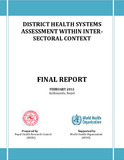Please use this identifier to cite or link to this item:
https://hdl.handle.net/20.500.14356/686Full metadata record
| DC Field | Value | Language |
|---|---|---|
| dc.contributor.author | Nepal Health Research Council (NHRC) | - |
| dc.contributor.author | World Health Organization | - |
| dc.date.accessioned | 2013-04-07T22:17:06Z | - |
| dc.date.accessioned | 2022-11-08T10:18:20Z | - |
| dc.date.available | 2013-04-07T22:17:06Z | - |
| dc.date.available | 2022-11-08T10:18:20Z | - |
| dc.date.issued | 2013 | - |
| dc.identifier.citation | Nepal Health Research Council | en_US |
| dc.identifier.uri | http://103.69.126.140:8080/handle/20.500.14356/686 | - |
| dc.description.abstract | Executive Summary: The WHO defines health systems as “all the organizations, institutions, and resources that are devoted to producing health actions”. Health sector projects engage with all levels and elements of the health system and frequently encounter constraints that limit their effectiveness. There are four key functions of the health system: (1) stewardship (often referred to as governance), (2) financing, (3) human and physical resources, and (4) organization and management of service delivery. On the other hand, Inter‐sectoral coordination among the different actors in the district that directly or indirectly has a role in strengthening and supporting the health system forms an important component of improved health system. The Alma Ata declaration has already reiterated inter‐sectoral coordination as one of its main component in achieving Health For All. In the NHSP IP II (2010‐2015), the MoHP has clearly put forward its stand in the importance of Inter‐sectoral coordination and collaboration and to have a lead role in areas of its comparative advance. This study was aimed to describe the major four key functions of the health systems and find out the situation of inter‐sectoral coordination that may have an equally important role in improving the function of health system. Furthermore, we also tried to identify on which areas of health systems requirements the inter‐sectoral coordination & collaboration plays a role. In the above context to achieve the above said objectives we chose two districts each from three ecological belts on the basis of performance indicators as reported by MoHP for the year 2066/67. Hence the districts selected for the study were Sarlahi and Rupandehi from Terai, Bhaktapur and Kaski from Hill and Sidhupalchowk and Rasuwa from Mountain. Within the selected district an in depth interview with the chief of DHO or DPHO as well as group interview with relevant personnel of D(P)HO was carried out using semi structured questionnaire. FGDs were also conducted with the organizations of health and non health sectors in the district along with D(P)HO chief and personnel of D(P)HO. Furthermore, a semi structured group interview was carried out with the In Charge and selected personnel as well as HFOMC members of one selected PHC in every district. The data received in such way was transcribed and then edited. The quantitative information was tabulated which was then summarized fro key findings. The findings from the FGDs which was mainly focused on finding out the situation of Inter‐sectoral coordination were summarized in four key thematic areas namely Existing Situation of Coordination, Problems and Constraints, Potential Areas for Coordination and Who should lead. The key findings in relation to the major key functions of district health systems showed that the overall management of the district health system happens under the leadership of chief of D(P)HO with the cooperation of all the personnel in different sections. The PHCs on the other hand have HFOMC in all of them as a management structure where members from marginalized, women and dalit are included and participate in the meetings in all the PHCs. | en_US |
| dc.language.iso | en_US | en_US |
| dc.publisher | Nepal Health Research Council | en_US |
| dc.subject | District health systems assessment within intersectoral context | en_US |
| dc.title | District health systems assessment within intersectoral context | en_US |
| Appears in Collections: | NHRC Research Report | |
Items in DSpace are protected by copyright, with all rights reserved, unless otherwise indicated.

